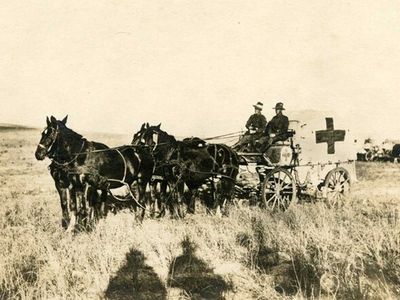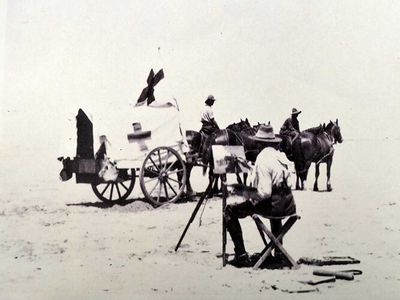“Major Avery, among many other Old Boys, holds a special place on the TGS Old Boys’ Wall of Achievement for his role in inventing the “Rapid Transit Ambulance” that was a key part of the Australian Light Horse Brigade.”

On ANZAC Day, we come together to reflect on the importance of service and sacrifice.
Toowoomba Grammar School would like to acknowledge our admiration for the loyalty, service and bravery exhibited by TGS Old Boys who so valiantly served. We are all the beneficiaries of their sacrifice, and their selfless actions continue to inspire a spirit of service amongst our current students.
Today we focus on the contribution of one TGS Old Boy who made a significant contribution to World War I. Here is some of the incredible story of Major Avery, DSO and if you visit the School Museum and Archives you can see a display in his honour.
Much of this history has been captured through countless hours of dedication and devotion by current TGS museum volunteer and former TGS staff member, Mrs Ann Hallam who managed the School’s Cadet Unit from 2006-2019.
Major Avery DSO, inventor of the WWI “Rapid Transit Galloping Ambulance”
Distinguished TGS Old Boy, Leonard Grimes (1880-1885) was born in Queensland in 1869 and died in 1953. Grimes attended the School in the days of Sir Harry Chauvel and Sir Littleton Groom and while at TGS was known as Leonard Avery Grimes.
After his School days he went on to Wadham College, Oxford, where he graduated with a medicine degree. He later changed his name to Conrad Avery and after some years as a hospital physician and surgeon, Avery enlisted with the British Army and joined the Suffolk Imperial Yeomanry. He was later promoted to Major and joined the Royal Army Medical Corps. During World War I he was enlisted with the Royal Westminster Dragoons and served in Palestine, Egypt and Syria.
Major Avery, among many other Old Boys, holds a special place on the TGS Old Boys’ Wall of Achievement for his role in inventing the “Rapid Transit Ambulance” that was a key part of the Australian Light Horse Brigade.
Light Horse Field Ambulance
The Light Horse units were mounted infantry with efficient mobile medical support to the wounded and sick soldiers of an Australian Light Horse Brigade. The Field Ambulance ensured the removal of the wounded from the front line to the advanced dressing station where there were surgical and resting tents.
These sand carts had two wheels with tyres that were wide enough to stop the cart digging into soft sand and could carry two or three stretchers. In heavy sand four horses were necessary to pull the cart, and the cart had to be steered by a rider on one of the lead horses.

Australian Light Horseman
The 2nd Light Horse Field Ambulance was formed in Brisbane with much of the unit coming from Queensland.
More than 15 TGS Old Boys enlisted with the Second Light Horse Brigade, two of whom died at Gallipoli: Major Dugald Maxwell Lockwood Graham and Trooper Gordon Holmes Robertson.
During the World War I, George W. Lambert (1873-1930) served Australia as an Official War Artist attached to the ANZAC Mounted Division. He spent two terms in service, the first with the Light Horse in Palestine, and the second in Gallipoli and Egypt before his military contract discharge.
As a result of Lambert’s service during World War I, he was offered a variety of commissions to paint scenes from significant war time events, including an activity of the 2nd Australian Light Horse Field Ambulance, Walk (An Incident at Romani).
The Battle of Romani was the last ground attack on the Suez Canal at the beginning of the Sinai and Palestine Campaign. The battle was fought from 3 to 5 August 1916 near the Egyptian town of Romani.
The completed painting was to be given to the Queensland (National) Art Gallery by the Light Horse in memory of their fallen comrades.
The Rapid Transit Ambulance
Major Avery describes his vision for a new galloping ambulance, known as “The Rapid Transit Ambulance”.
This ambulance was designed with a view to filling the want of stretcher bearers with mounted troops. The endeavor has been to construct a light strong carriage easily adjustable to any mounted horse and capable of keeping up with cavalry through any sort of country. As will be seen from the accompanying illustration, the ambulance is a two-wheeled contrivance.
The body consists of a platform fixed to a crank axle by long springs between 46-in. wheels. This platform is 2 ft. 3 in. from the ground and is arranged to carry an ordinary service stretcher. The forepart consists of a pair of short shafts which are attached to the body by an arrangement of springs adapted to prevent the side-to-side motion caused by the action of the horse. The shafts reach as far forward as the saddle flaps, where they are held in position by a girth strap, breastplate, and belly-band.
The body is covered by a canvas hood. The weight is about 3 cwt. Length overall, 12 ft. Track, 4ft. 1 in. Surgical dressings, splints, water-bottle, &c., are carried. It is quite easy for the driver, having placed a wounded or helpless man in a stretcher, to transfer him from the ground to the platform of the carriage single-handed.
This ambulance has been on duty with the Suffolk, Sussex, Surrey and Middlesex Imperial Yeomanry during their respective training, and with the Wiltshire Yeomanry through the recent maneuvers. It is a very comfortable conveyance and has proved capable of negotiating with almost any country.
Walk (An Incident at Romani)
The incident to which Lambert’s painting refers occurred during the Battle of Romani on 4 August 1916. The 2nd Light Horse Field Ambulance had deployed two sand-carts to an exposed part of the line to retrieve some seriously wounded men. Upon its return journey the Field Ambulance envoy came under Turkish fire and its panicked horses started to bolt.
Tragedy was averted when the corporal signaled ‘Walk’ and galloped to the front of the party to steady the teams. After the horses had been calmed and resumed their pace, the enemy apparently recognised the Ambulance’s mission and averted their fire. As a result of their bravery and composure during the incident the corporal and drivers were awarded Military Medals.

To enable Lambert to make sketches of the event that was already three years in the past, it was re-enacted at Kantara, Egypt in 1919. Photographs were taken of Lambert at work sketching this re-enactment. The completed painting portrays the moment when the corporal signals ‘Walk’ whilst rushing to the front of the group to steady the bolting teams.
Remembrance Day
Remembrance Day marks the anniversary of the Armistice which ended the First World War, signed at 11:00am on 11 November 1918. We still remember those who have given their lives in conflict before and since, by taking a minute to stop, be silent and remember the war that was to end all wars.
Latest Blog
Developing Teachers Worldwide
I recently had the pleasure of attending the 2023 International Boys’ Schools Coalition (IBSC) Annual Conference at Westlake Boys High School in Auckland, New Zealand, in my capacity as a Team Leader in the IBSC Action Research Program. Action research is a systematic inquiry conducted by teachers in their own classroom to better understand the impact that an aspect of their practice is having on their students. Each year, 40 teachers from IBSC member schools from around the world are accepted…
Developing a Sense of Belonging for our TGS Boarders
How do we adequately develop a teenager’s 'sense of belonging' in boarding? Head of Boyce House, Boarding, Mr Michael Hall has investigated how 'Maslow's Hierarchy of Needs' applies to boarding. It is a psychological theory that suggests human beings have a set of fundamental needs that must be fulfilled in a hierarchical order. The theory proposes that individuals must first satisfy their physiological needs before moving on to higher-level needs, such as the 'belongingness' that is so…
Kia Moemoeā – Dream Beyond Limits
A 12-year study has found that boys consistently perform better in an all boys’ school compared to boys in co-educational schools. This was one of several interesting topics presented at the recent International Boys’ Schools Coalition (IBSC) Conference in Auckland, New Zealand which I attended alongside three of my Toowoomba Grammar School colleagues – Mr Luke Rawle, Mr Dave Klan and Mrs Jessica Galbraith. We joined 600 leading educators from 15 countries around the world for the four-day…
Blue and Gold in the Blood
“I had such fond memories from the School and enjoyed all the opportunities available, particularly participating in sport and learning at such a high level; my sons were going to have the same great education,” said Chris adamantly. Chris was a boarder from Dalby and an “all-rounder” as a student. He was part of the 1st XV, a CUO in the Cadets, a member of the debating team, involved in drama (featuring in two plays during his time) and a good academic student. “I really enjoyed boarding,”…
The Benefits of Repeated Reading
An effective and evidence-based method that can significantly improve your child's reading abilities is repeated reading. Reading proficiency is a vital skill that sets the foundation for academic success and lifelong learning. Repeated reading, a simple yet powerful technique, has been proven to enhance reading fluency, comprehension, and overall confidence. Let's delve into why repeated reading is such a beneficial practice for your child. Research consistently supports the benefits of…
Print v Digital
I recently read an article by Petra Stock, entitled "Streaming Stories: Will Children’s Digital Book Platforms Upend Print", an interesting discussion comparing ebooks and print media and the ways they are being used during and post COVID. Which is better according to the article? Well, there is a clear winner; however, like many things, the answer can depend on the situation. I'd like to break elements of the article down, along with my own thoughts and compare the two. Social…
Striking a Balance
We understand that, as parents, we aspire to provide our children with the best education and opportunities for growth. Within the Junior School at Toowoomba Grammar School, we believe in fostering a love for learning while enabling your son to reach his full potential. In this article, we would like to emphasise the significance of automaticity and basic skill practice in extending your child's learning journey, while emphasising the importance of respecting their individual pace. Automaticity…
Developing Sportsmanship from Prep
Overwhelming pride in wearing the Blue and Gold is a familiar emotion for Toowoomba Grammar School students, as is abundantly evident in all our boys, from Prep to Year 12. This emotion and passion for the School is the essence of our TGS culture and defines what it means to be a TGS student. The launch of the 2022 - 2026 Strategic Plan creates an exciting opportunity for our co-curricular program, which links perfectly into the "character and wellbeing" pillar. The development of good…
Why Study Drama?
As an educator with over 30 years’ experience in the Arts, I specialise in the analytical, creative and practical spheres that quantify and qualify success in drama. I have been a Drama teacher and Arts Project Officer in the Independent, Catholic, state, and private sectors in primary and secondary, single sex and co-educational environments. This longevity of knowledge, gained through firsthand experience, affirms that students who study drama through until at least Year 10 acquire…